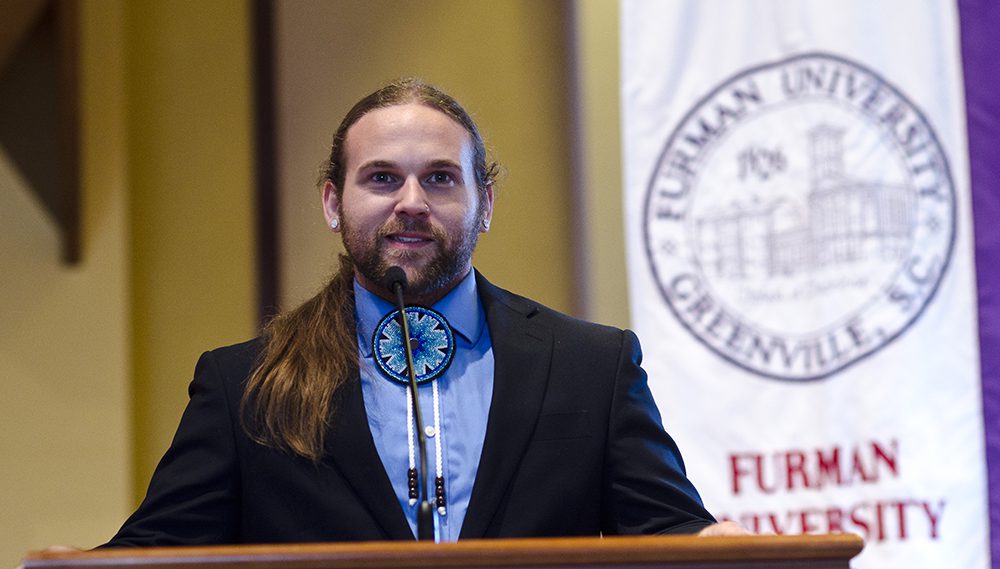Standing Rock youth and the Dakota Access Pipeline

Justin Fox borrowed some of his big brother’s clothes for his first trip to Furman. He was both “nervous and excited” to perform in front of a big group of college students.

Standing Rock High School student Justin Fox performs traditional dance.
He wore bustles of feathers on his arms and back, a headpiece of porcupine and deer hair, and a patterned breechcloth in a rainbow of colors, entirely handmade.
Fox was ready for his war dance.
“I hope my brother passes this down to me one day because it’s obviously beautiful,” said Fox, who plans to major in architecture when he leaves for college this fall.
In many ways, Fox is your average high school senior. But he and his classmates at Standing Rock High School in Fort Yates, N.D., also have a unique set of challenges as teenagers growing up on a Lakota Sioux Indian Reservation.
Fox and fellow Native American students Chaska Moore, Aliya Martinez and Jalyssa McLaughlin traveled to Furman for a special program April 20 at Daniel Chapel, “Culture and Controversy: Standing Rock Youth and the Dakota Access Pipeline.” The event, which included traditional dance performances and a question-and-answer session, was part of Furman’s Cultural Life Program.
Their visit was hosted by the Furman Departments of History, Religion, Asian Studies, and Politics and International Affairs; the Riley Institute; the Shi Center for Sustainability; Diversity and Inclusion Initiatives in Student Life; Environmental Action Group; Catholic Campus Ministries; Student Diversity Council; Amnesty International and the College Democrats.
After graduating with degrees in history and Asian studies from Furman, Phillip “Tex” Stewart ’12 made his way to North Dakota where he began teaching history and coaching football at Standing Rock High School.
Martinez, one of Stewart’s students, came to him with the idea of visiting colleges and universities to provide a student perspective on Lakota culture and community, along with the impact of the Dakota Access Pipeline, a $3.7 billion project that would carry oil 1,170 miles through four states.
While some have argued the pipeline would create jobs and boost the economy, the Lakota Sioux tribe view the pipeline as both an environmental threat and a culturally-offensive project that would desecrate the burial grounds of their ancestors.

Phillip “Tex” Stewart ’12 speaks to the Furman community.
Wearing a traditional face paint of red dirt and grease called wasa’, Martinez spoke about the challenges she and her family have faced for speaking out against the pipeline. Her father is one of the tribal councilmen.
As a 17-year-old high school junior, she has been exposed to mace, water cannons (in below freezing temperatures), tear gas and noise cannons at the protest sites. Just traveling to Bismarck to shop for groceries has exposed her to harassment and racist remarks, one more reason she wants to educate others about Lakota Sioux culture.
“We don’t live in teepees. We don’t get government handouts . . . We’re not a bunch of drunks,” said Martinez. “I want to change peoples’ opinions about my people. I’m really proud of my people.”
No matter what ends up happening with the pipeline, “they can’t silence us anymore,” she said.
In the meantime, Standing Rock High School juniors and seniors said they were looking forward to attending their high school prom when they returned home last weekend. They’re also trying to focus long-term on future educational and career goals.
“I want to prove people wrong. I want to show how ambitious and resilient I can be. I want to make my family proud,” said Fox. “I feel lucky almost.”
“As a historian, I hope that everyone in the audience uses the Standing Rock students’ honest and poignant narratives as an opportunity to learn more about indigenous wisdom of communities who have lived on this land far longer than anyone else in the room and who have been subjected to centuries of injustice,” said James B. Duke Associate Professor of Asian Studies and History Savita Nair. “In the end, historians know that more narratives and more voices offer the most responsible and complete way of learning about the past.”